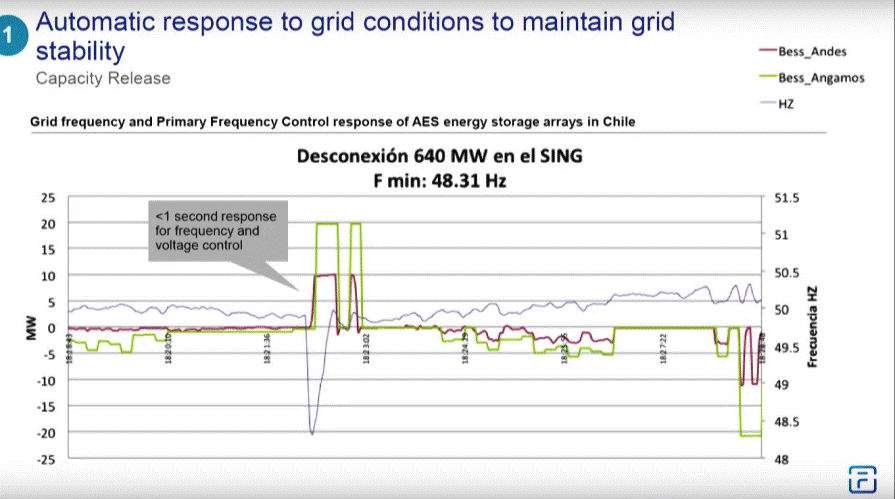

Most people take electric power for granted and few understand the complexities involved to keep the power flowing without interruptions. There is great public demand for clean renewable power, but utilities fear that these non-dispatchable renewables will disrupt our electric grids. We’ve all witnessed the impact of occasional power failures. Thankfully, according to FERC, outages caused by failed protection system equipment, AC substation failures, or human error, have decreased over the past five years. This, despite the fact that solar and wind are the major new source of generation and older base load power from coal and nuclear plants have been closing. So, what happened? How can grid stability be improving?
In the old days, i.e. just 10 years ago, the conventional wisdom held that the grid needs enough spinning reserves available to handle sudden load changes. There was great concern that retiring base load coal and nuclear plants would reduce the spinning reserves and make grid frequency harder to control. All modern grids use the grid frequency to balance generation and loads. All generators and loads use the same frequency on an electric grid. 50Hz in Europe and 60Hz in the US are the standards for grid frequency, although many other grid frequencies once existed before Europe went to a single grid and the US into three main grids. The exact frequency of the grid varies around the nominal frequency, reducing when the grid sees heavy loads, and speeding up as loads lighten. A large factory can suddenly increase the load, dropping the frequency slightly. A large grid will have many spinning gas, steam, and water turbines and these will all respond together as a group, likely using the 4 percent droop rule (relation of rotational speed to power), AGC (Automatic Generation Control), to share the load. Where grids have areas connected with tie-lines, a slower control integration function, (LFC) Load-Frequency Control, rebalances the load within these areas and ensures the grid frequency is precisely returned to the nominal frequency. With more spinning rotational inertia, the frequency is more stable. In this model, a large grid with massive spinning reserves and strong tie-lines, can easily handle the largest industrial loads, so why is grid reliability improving as spinning reserves are declining?
Grids are regulated for reliability and the ability to regulate the frequency accurately is legislated and monitored by FERC in the US. Utilities and grid operators recognized they need grid equipment that can keep the electric grid stable and grid frequency is the main ancillary service for this. There is, in fact, a market for frequency control and generation companies are paid to provide that grid stabilizing service.
The gas turbines of many smaller natural gas power stations are, in part, helping to replace for the retiring spinning reserves of the steam turbines in coal and nuclear plant. New gas turbines may have less rotating mass, but the newest generation of gas turbines can respond to load changes much faster than steam turbines, with greatly improved time-to-generation from a cold start. These gas turbines can compete in the frequency control market, but also help stabilize the grid by providing other ancillary services like picking up the load when large generating sources have outages.
Grid regulations are changing worldwide to allow grid-scale batteries and energy-storing flywheels participate in the ancillary services markets. In a previous blog post, we mentioned how the mid-Atlantic ISO (Independent, System Operator) PJM, helped to establish lithium batteries as a viable alternative for grid frequency control. The key advantage of batteries is that they can respond about 10 times faster than gas turbine speed controls. While batteries may not be economical for large-scale energy storage (days), batteries can often provide power for up to four hours, which is long enough to help meet peak loads. Flywheels can also respond quickly and, with magnetic bearings, can store power for hours and days without losing speed, but generally have lower energy storage than batteries. Also, their life is not significantly impacted by charge cycle.

In the chart, utility AES demonstrates how a battery system can respond quickly to a load changes to regulate grid frequency. AES has teamed up with Siemens to form Fluence energy, just one of many grid-scale battery and microgrid suppliers. The groundbreaking work that PJM has done with lithium batteries used for grid frequency control is being noticed by grid regulators in other countries. Utilities worldwide are accommodating microgrids and batteries as a better way to keep their grids reliable at the lowest cost. Suppliers are quickly gearing up for a market that is expanding fast.
For more detailed information please refer to the ARC study on Microgrid Automation.

